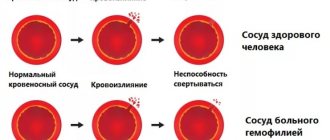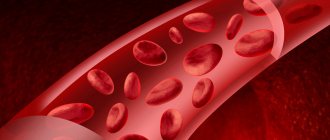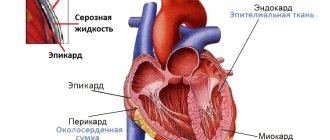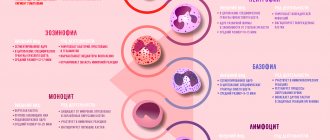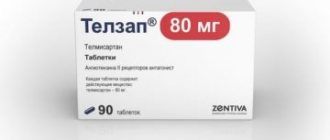Release form, composition and dosage of the drug
The blood pressure drug Equator is presented on the pharmaceutical market in tablet form. Main active ingredients of tablets:
- Amlodipine besilate - at a dosage of 6.94 mg or 13.88 mg;
- Lisinopril dihydrate - in dosages ranging from 10.88 mg to 21.76 mg.
This combination product includes such auxiliary components as magnesium stearate, carboxymethyl starch, cellulose.
The medicine is sold in cardboard packages, each of which can contain from 1 to 3 blisters (10 tablets in one blister).
Tablets Equator
Pharmacological action and pharmacokinetics
Medicine Equator is a combined medication for high blood pressure, which includes two main components. The optimal combination of active ingredients ensures faster action of the tablets and helps to increase the effectiveness of the therapeutic course. The therapeutic effect is achieved thanks to the following ingredients:
- Amlodipine is characterized by the presence of pronounced hypotensive properties. Blocks the flow of calcium into the smooth muscles of the vascular walls, as well as the cellular structures of the myocardium. Reduces the load on arterioles and arteries, ensuring the achievement of an antianginal effect. When using tablets containing this substance, patients become more resistant to physical activity, their body requires less nitroglycerin. The drug also reduces the likelihood of angina attacks. Amlodipine is characterized by cardioprotective properties, the ability to reduce hypertrophy of the left cardiac ventricle and reduce the manifestations of sclerotic changes in blood vessels. The duration of action is 24 hours.
- Lisinopril - has vasodilating properties, helps stabilize blood pressure. The substance dilates arteries and increases blood supply to the myocardium. When used regularly, it helps the patient’s body adapt to increased physical activity and helps increase life expectancy in people suffering from heart failure.
Blood pressure levels decrease noticeably an hour after taking the pills. The effect of the drug lasts for a day or even more. The tablets do not cause addiction or withdrawal symptoms after completion of treatment.
The maximum concentration of active substances in the patient’s blood is observed 6 hours after taking Equator tablets. Bioavailability indicators are about 29%, absorption - 60%.
The medicine is absorbed by the body by 90%, entering the patient’s gastrointestinal tract. It is excreted 60% in the form of metabolites, and 10% via the renal apparatus. Metabolites (about 25%) leave the patient’s body through the intestines.
Amlodipine and Lisinopril
The age category of the patient, as well as food intake, do not have a significant effect on the absorption and assimilation of the active ingredients of the medication. Long-term circulation of the active components of Equator blood pressure tablets allows you to take them only once a day.
Astronomy solution book for grade 11 for lesson No. 2 (workbook) - Celestial sphere
Astronomy solution book for grade 11 for lesson No. 2 (workbook) - Celestial sphere
1. Complete the sentence.
A constellation is a section of the starry sky with a characteristic observable group of stars.
2. Using a star chart, enter diagrams of constellations with bright stars in the appropriate columns of the table. In each constellation, highlight the brightest star and indicate its name.
| Constellation | Constellation diagram | Constellation | Constellation diagram |
| Big Dipper | Twins | ||
| Ursa Minor | Swan | ||
| Bootes | Orion | ||
| a lion | Lucky |
3. Complete the sentence.
Star maps do not indicate the positions of planets, since maps are intended to describe stars and constellations.
4. Arrange the following stars in descending order of their brightness:
1) Betelgeuse; 2) Spica; 3) Aldebaran; 4) Sirius; 5) Arcturus; 6) Chapel; 7) Procyon; Vega; 9) Altair; 10) Pollux.
2) Spica; 3) Aldebaran; 4) Sirius; 5) Arcturus; 6) Chapel; 7) Procyon; Vega; 9) Altair; 10) Pollux.
| 4 | 5 | 8 | 6 | 7 | 1 | 3 | 9 | 2 | 10 |
5. Complete the sentence.
1st magnitude stars are 100 times brighter than 6th magnitude stars.
The ecliptic is the apparent annual path of the Sun among the stars.
6. What is called the celestial sphere?
An imaginary sphere of arbitrary radius.
7. Indicate the names of the points and lines of the celestial sphere, indicated by numbers 1-14 in Figure 2.1.
- North celestial pole
- zenith; zenith point
- vertical line
- celestial equator
- west; west point
- center of the celestial sphere
- noon line
- south; south point
- skyline
- East; east point
- south celestial pole
- nadir; current nadir
- north point
- celestial meridian lines
8. Using Figure 2.1, answer the questions.
How is the axis of the world located relative to the earth's axis?
Parallel.
How is the axis of the world located relative to the plane of the celestial meridian?
Lies on a plane.
At what points does the celestial equator intersect the horizon?
At the points of the east and west.
At what points does the celestial meridian intersect with the horizon line?
At points north and south.
9. What observations convince us of the daily rotation of the celestial sphere?
If you observe the stars for a long time, the stars will seem like a single sphere.
10. Using a moving star chart, enter into the table two or three constellations visible at latitude 55° in the Northern Hemisphere.
The solution to task 10 corresponds to the reality of the events of 2020, however, not all teachers check the solution of each student’s task on the star map for compliance with reality
| Patch of starry sky | Option 1: 15 Sep at 21:00 | Option 2: 25 Sep at 11 p.m. |
| Northern part | Ursa Major and Ursa Minor | Ursa Major, Lynx |
| South part | Capricorn, Sagittarius | Capricorn, Aquarius |
| West Side | Snake, Bootes, Virgo | Hercules, Snake |
| East End | Aries, Cepheus, Arrow | Taurus |
| Constellation located at the zenith | Swan, Pegasus | Lizard, Cassiopeia |
Clinical indications
Experts identify the following clinical indications for the use of Equator blood pressure tablets:
- Hypertension;
- Arterial hypertension;
- Metabolic disorders;
- Asthenic conditions;
- Permanent excessive physical, nervous, psycho-emotional stress;
- Neuroses;
- Chronic fatigue syndrome;
- Vegetovascular dystonia;
- Heart failure.
It is recommended to take the tablets during the recovery period, after suffering infectious or somatic diseases. It is possible to prescribe this medication to patients suffering from diabetes mellitus as one of the components of complex therapy.
About contraindications
Equator tablets for blood pressure have the following clinical contraindications:
- Reduced blood pressure;
- Hypertrophic cardiomyopathy;
- Increased tendency to exhibit allergic reactions (Quincke's edema, urticaria);
- State of cardiogenic shock;
- Unstable angina;
- Individual intolerance and hypersensitivity to the ingredients contained in the tablets;
- Heart failure resulting from myocardial infarction;
- Aortic stenosis;
- Edema is idiopathic;
- Mitral heart valve stenosis;
- Angioneurotic hereditary edema.
- Renal failure occurring in acute form.
It is prohibited to use the drug Equator to normalize blood pressure in pregnant women and patients under the age of 18 years.
Pregnancy is an absolute contraindication for taking Equator
With particular caution, tablets are prescribed to patients who have the following health problems:
- Renal artery stenosis;
- Diabetes;
- Cardiopalmus;
- Disruption of cerebral circulation processes;
- Acute form of heart attack;
- Bradycardia (slow heart rate);
- Coronary insufficiency;
- Decreased blood volume (hypovolemia);
- Cerebrovascular disorders;
- Autoimmune lesions of connective tissue structures;
- Cardiac ischemia.
Patients with the diseases listed above can take the drug Equator only as prescribed by the attending physician. The specialist must monitor the patient’s condition, determine the optimal dosage of tablets and the duration of the therapeutic course, on an individual basis.
Side effects
In general, the medicine is well tolerated by most patients. According to the instructions, the side effects of the medication are due to the characteristic features of the two active ingredients that are part of the Equator tablets. Instructions for use indicate the following possible side effects from the cardiovascular system:
- hypotension (decrease in blood pressure below 90/60 mm Hg);
- rapid heartbeat (beat rate above 100 beats per minute);
- bradycardia;
- acute coronary syndrome (in patients at high risk of developing cardiovascular events);
- disturbance of the sinus rhythm of the heart, the occurrence of blockades of the cardiac impulse;
- ischemic stroke due to a rapid or excessive decrease in blood pressure;
- vasculitis (inflammation of the walls of blood vessels);
- the appearance of swelling in the lower extremities, especially in the evening;
- a burning sensation or pain in the chest.
If the patient has hypersensitivity to any of the components of the Equator, allergic reactions of varying severity develop. They manifest themselves according to the instructions for use as skin rash, a feeling of heaviness in the abdomen, indigestion, angioedema of the neck and head.
Also, Equator tablets for normalizing blood pressure affect the metabolic processes of blood glucose, which sometimes leads to an increase or decrease in its concentration in the blood. According to the instructions for use, cases of toxic effects of tablets on the liver are described with an increase in enzyme levels (AST, ALT), bilirubin, and in some patients - with the development of toxic hepatitis. There was inhibition of hematopoietic processes with a drop in the number of formed elements in the blood.
In some patients, while taking it, there was a violation of the filtration function of the kidneys and an increase in creatinine concentration. Episodes of frequent urination and pain during this process were also noted. From the nervous system, according to the instructions for use, cases of the following side effects have been recorded:
- drowsiness or sleep disturbances;
- severe dizziness, short-term loss of consciousness (syncope) due to decreased blood pressure;
- disturbance of sensory systems (tinnitus, changes in taste);
- paresthesia (feeling of crawling, numbness of body parts, areas of skin);
- increased muscle tone of the limbs;
- depression;
- emotional lability;
- increased fatigue, decreased performance when performing mental tasks;
- decreased vision;
- impaired coordination of precise movements.
Among the other side effects of the drug Equator, the instructions for use highlight the development of cough in patients due to lisinopril, broncho-obstructive syndrome, and the appearance of shortness of breath (due to heart failure). There is information about cases of sexual dysfunction in men with long-term use of the medication.
Side effects of pills
The use of Equator tablets for pressure can provoke the following undesirable reactions:
- Peripheral swelling;
- Painful sensations localized in the chest area;
- Gynecomastia;
- Convulsive syndrome;
- Difficulty urinating;
- Dermatitis;
- Hair loss;
- Manifestation of allergic reactions;
- Myalgia;
- Asthenic syndrome, general malaise, weakness, decreased ability to work;
- Arthrosis;
- Arthralgia;
- Painful sensations in the back area;
- Erectile dysfunction.
In addition, each of the active ingredients included in the drug also has its own side effects.
Amlodipine can cause the following unpleasant symptoms:
- Head fights;
- Attacks of dizziness;
- Cardiopalmus;
- Drowsiness during the daytime;
- Heart rhythm disturbances;
- Painful sensations localized in the abdominal area;
- Dyspepsia;
- Nausea and vomiting;
- Feeling of permanent thirst;
- Diarrhea.
Headache attacks
When using lisinopril, there is a possibility of the following side effects:
- Paresthesia;
- Sleep disorders;
- Stomach ache;
- Intestinal disorders;
- Skin itching;
- Allergic rashes such as urticaria;
- Gynecomastia;
- Increased fatigue;
- Erectile disfunction.
In most cases, the side effects listed above go away on their own and do not require discontinuation of the drug or special treatment.
Geography of the Earth's equator
World map with the equator line
We can assume that our planet has the shape of a ball with an average radius of 6371.3 km. But this representation is not entirely correct and is not always suitable for accurate calculations. If we take scientific concepts and numbers, then the Earth is not a perfect sphere; in the world of experts, its shape is described by the concepts of geoid or ellipsoid.
The imperfection of the shape of our home planet was discovered back in the 17th century by Isaac Newton and Christiaan Huygens. Due to rotation around its axis and the resulting centrifugal force, which reaches a peak at the equator and zero at the poles, the planet rather has the shape of an oblate ball. Because of this, the polar radius is 21.38 km less than the equatorial radius.
Interesting fact : the Congo River, flowing in Central Africa, is the deepest and second longest on the continent. But the most interesting thing about it is that it is the only river in the world that crosses the equator twice.
The planet reaches its highest rotation speed at zero latitude. This fact can easily be explained by the maximum radius of the Earth precisely at the equator. So the length of the equator is 40,075
km
, and if this number is divided by 24 hours (the time during which the planet makes one revolution), then you can find out the speed of rotation of the Earth at zero latitude.
Thus, at the equator it is approximately 1670 km/h. The closer to the poles, the lower the speed. Interesting: Gravel sand and clay: description, photo and video
Instructions for use
Equator blood pressure tablets, according to the instructions for use, can be taken at any time of the day, regardless of meals.
The recommended daily dose of the medication is 1 tablet. The maximum daily dosage should not exceed 1.5 tablets.
In order to avoid manifestations of arterial hypotension, several days before the start of the therapeutic course, it is necessary to refrain from using diuretics and diuretics.
The dosage for patients suffering from renal and liver failure is determined by the attending physician on an individual basis. Therapy begins with minimal doses, gradually increasing them, while strictly monitoring the patient’s condition and the changes occurring in him. If negative symptoms occur, the drug should be discontinued or replaced with a more suitable analogue.
Composition of the drug Equator
The medication contains amlodipine and lisinopril. These active ingredients have a long history of use for the treatment of hypertension.
Amlodipine
Amlodipine is a selective calcium channel blocker. According to the instructions for use, its action is based on the ability to reduce the flow of individual ions into the muscle cells of the heart and blood vessels.
This leads to their expansion and a decrease in peripheral pressure - one of the key components of hypertension. At the same time, amlodipine has a pronounced cardioprotective effect, since it improves blood supply to the heart muscle and reduces the load on it.
Lisinopril
Equator tablets contain lisinopril, one of the most common ACE (angiotensin-converting enzyme) inhibitors. It has been used in practice since the early 90s of the 20th century. Its difference from other tablets in this group is its longer duration of action.
special instructions
In people with impaired renal function, while taking Equator, an increase in urea and creatine levels in the blood is possible. In such cases, it is recommended to discontinue treatment with this drug.
People taking diuretics should restore fluid and sodium losses before starting a therapeutic course in order to prevent a sharp decrease in systolic blood pressure, accompanied by extremely unpleasant clinical signs.
Patients with kidney pathologies should take the drug with caution
Discontinuation of Equator tablets is indicated in case of adverse reactions such as anaphylactic shock, angioedema.
Treatment should be carried out under strict medical supervision in patients suffering from the following diseases:
- Metabolic acidosis;
- Mitral valve stenosis;
- Vascular collagenosis;
- Heart failure;
- Nonproductive cough syndrome.
Regular monitoring of body weight and preventive examinations with a dentist are recommended, aimed at preventing possible gum bleeding and hyperplasia.
Equator tablets can cause a sharp drop in blood pressure, weakness, and attacks of dizziness. During the therapeutic course, it is recommended to refrain from driving vehicles and other activities that require increased concentration and reaction speed.
Use for renal impairment
In case of renal failure and CC 30-70 ml/min, half the usual initial dose is prescribed (since lisinopril is excreted by the kidneys). The maintenance dose depends on the individual response of the patient; during therapy, regular monitoring of renal function, potassium and sodium levels in the blood is required.
If renal function is impaired, for example, with renal artery stenosis (especially bilateral or with stenosis of the arteries of a single kidney), taking the drug can provoke deterioration of renal function and acute renal failure, reversible after cessation of treatment.
Features of use during pregnancy and childhood
Equator tablets for blood pressure are contraindicated for women expecting the birth of a baby and breastfeeding mothers. In the later stages of pregnancy, the active ingredients of this drug can provoke in the unborn child the development of pathologies such as renal failure, hypotension, hyperkalemia, and deformation of bone tissue structures.
Equator should not be taken during breastfeeding, since the components of the tablets have the ability to penetrate into milk. For this reason, if a woman needs treatment with this drug, the baby should be switched to artificial feeding.
Equator is also not used for the treatment of small patients who have not reached the age of majority, due to the lack of sufficient data confirming the safety of the drug for the child’s body.
The use of Equator tablets in childhood is prohibited
Pregnancy and lactation
The drug is contraindicated for use during pregnancy.
If pregnancy is detected, treatment should be stopped as soon as possible.
Taking lisinopril in the second and third trimesters of pregnancy can cause damage and death to the fetus as a result of the effect on its kidneys (hypotension, renal failure, hyperkalemia). A decrease in the amount of amniotic fluid can lead to deformation of the skull and face, impaired development of the limbs, pulmonary hypoplasia and fetal death. There are no data on similar or other effects in earlier pregnancy.
Taking the drug during lactation is contraindicated due to the excretion of amlodipine in breast milk. There are no data indicating that lisinopril passes into breast milk.
What to do in case of overdose?
An overdose of Equator blood pressure pills is manifested by the following symptoms:
- Tachycardia (rapid heartbeat);
- Decrease in blood systolic pressure;
- State of shock.
With such symptoms, it is important to provide the patient with timely medical care, since there is a possibility of death as a result of pronounced arterial hypotension.
Treatment of overdose with Equator is carried out according to the following scheme:
- Gastric lavage, inducing artificial vomiting;
- The use of sorbents, activated carbon.
- The use of drugs whose action is aimed at maintaining the functioning of the hematopoietic and cardiovascular systems.
- The use of medications with vasoconstrictor properties.
- Intravenous administration of calcium gluconate.
During treatment, it is important to monitor changes in the patient's blood and urine test results.
Pharmacology
The drug Equator contains two active ingredients - lisinopril dihydrate and amlodipine besylate, which are also produced as separate pharmaceutical preparations for the treatment of diseases of the cardiovascular system. Their combination is designed to enhance the therapeutic effect due to the synergy of both components. The use of a complex drug is recommended if it was not possible to achieve the desired results with monotherapy with one of them.
Important information: Does Canephron increase or decrease blood pressure?
Both active ingredients have almost the same positive effect on the metabolic processes of the circulatory system, but do not interact with each other. Their proportionality in the composition of Equator can be distinguished by the manufacturer’s engraving on each tablet, mg:
- A+L – Amlodipine 5 + Lisinopril 10.
- CF2 – Amlodipine 5 + Lisinopril 20.
- CF3 – Amlodipine 10 + Lisinopril 20.
Lisinopril
An ACE inhibitor has the ability to reduce peripheral vascular resistance and pulmonary capillary pressure. Lisinopril, by suppressing the formation of vasoconstrictor peptide catalysts, reduces systolic and diastolic blood pressure.
Unlike similar substances involved in metabolism, it does not affect glucose levels, which allows it to be used by people prone to diabetes. It has a direct effect on kidney function, reduces renal vascular resistance and reduces albuminuria (increased protein in the urine), which can manifest itself as a consequence of metabolic disorders in heart disease.
Begins to act within 1 hour after entering the stomach. It reaches its maximum concentration after 6 hours and gradually decreases throughout the day. It does not accumulate in the body and is excreted unchanged.
Amlodipine
It is an antagonist of calcium ions, that is, it inhibits their penetration into the vessels and tissues of the heart muscle. Its vasodilatory effect occurs due to the dilation of the coronary and peripheral arteries. An increase in the volume of peripheral arterioles reduces the myocardial need for oxygen and additional energy, as a result, the load on the heart decreases and its work normalizes. After 7 days of daily use of amlodipine, the frequency of angina attacks and blood pressure levels decrease.
The maximum concentration in the blood plasma is observed 6-12 hours after it enters the stomach. It does not depend on the patient’s physical activity and food intake, which makes it possible to use it for the treatment of sedentary patients. The period of absorption and excretion from the body involves use no more than once a day.
Interaction with other drugs and alcohol
Simultaneous use of the drug Equator for blood pressure with diuretics enhances the hypotensive effect of the tablets.
Combination with rifampicin, medications containing St. John's wort, and antiepileptic medications decreases the levels of amlodipine, which significantly reduces the effectiveness of the therapeutic course.
Combination with nonsteroidal anti-inflammatory drugs partially suppresses the antihypertensive effect of lisinopril.
In order to avoid the development of hyperkalemia, with the simultaneous use of diuretics with potassium-sparing properties and Equator pressure tablets, during the therapeutic course, it is necessary to constantly monitor the level of potassium in the patient’s blood.
When treated with Equator, it is recommended to refrain from drinking alcoholic beverages and alcohol-containing products. This is due to the fact that ethyl alcohol enhances the hypotensive effect of the main active ingredients of the tablets. The result can be a number of adverse reactions that are dangerous to the body.
When taking the drug Equator, you should avoid alcohol.
Drug interactions
Lisinopril
Potassium-sparing diuretics (eg, spironolactone, amiloride, and triamterene), potassium supplements, potassium-containing salt substitutes, and other medications that can increase serum potassium levels (eg, heparin) may cause hyperkalemia when combined with ACE inhibitors, especially in patients with a history of renal failure and other kidney diseases. When prescribing a drug that affects potassium concentrations concomitantly with lisinopril, serum potassium concentrations should be monitored. Therefore, simultaneous administration should be carefully justified and carried out with extreme caution and regular monitoring of both serum potassium levels and renal function. Potassium-sparing diuretics can be taken together with Equator® only under medical supervision.
If a diuretic is prescribed to a patient receiving Equator®, the hypotensive effect is usually enhanced. Therefore, it is necessary to take Equator® with extreme caution in combination with diuretics.
Lisinopril mitigates the kaliuretic effect of diuretics.
With the simultaneous use of other antihypertensive drugs, the hypotensive effect of Equator® may be enhanced.
When taken simultaneously with nitroglycerin, other nitrates or vasodilators, a more pronounced decrease in blood pressure is possible.
When used simultaneously with ACE inhibitors, tricyclic antidepressants/antipsychotics, general anesthesia, opioid analgesics: a more pronounced decrease in blood pressure is possible.
Ethanol enhances the hypotensive effect of the drug.
Allopurinol, procainamide, cytostatics or immunosuppressants (systemic corticosteroids) may increase the risk of developing leukopenia when used simultaneously with ACE inhibitors.
Aitacids and cholestyramine, when taken simultaneously with ACE inhibitors, reduce the bioavailability of the latter.
Sympathomimetics may reduce the hypotensive effect of ACE inhibitors; it is necessary to carefully monitor the achievement of the desired effect.
When taking ACE inhibitors and hypoglycemic drugs (insulins and oral hypoglycemic agents) simultaneously, the likelihood of a decrease in blood glucose concentrations and the risk of hypoglycemia may increase. This phenomenon is most often observed during the first week of combination treatment and in patients with renal failure.
With long-term use of NSAIDs, including acetylsalicylic acid in high doses, the effectiveness of ACE inhibitors may decrease. The additive effect when taking NSAIDs and ACE inhibitors is manifested by an increase in serum potassium levels and can lead to a deterioration in renal function. These effects are usually reversible. Very rarely, acute renal failure may develop, especially in elderly patients and patients in a state of dehydration.
Lithium excretion may be slowed during concomitant use with ACE inhibitors and therefore serum lithium concentrations should be monitored during this period. When used together with lithium drugs, it is possible to increase the manifestation of their neurotoxicity (nausea, vomiting, diarrhea, ataxia, tremor, tinnitus).
With the simultaneous use of ACE inhibitors and gold preparations (sodium aurothiomalate) intravenously, a symptom complex has been described, including facial flushing, nausea, vomiting and arterial hypotension.
Amlodipine
Studies in elderly patients have shown that diltiazem suppresses the metabolism of amlodipine, probably due to inhibition of the CYP3A4 isoenzyme (plasma concentration increases by almost 50% and the effect of amlodipine is increased). We cannot exclude the possibility that stronger inhibitors of the CYP3A4 isoenzyme (i.e. ketoconazole, itraconazole, ritonavir) are capable of increasing the plasma concentration of amlodipine to a greater extent than diltiazem. Concomitant use should be done with caution.
When used simultaneously with inducers of the CYP3A4 isoenzyme - with antiepileptic drugs (for example, carbamazepshyum, phenobarbital, phenytoin, fosphenytoin, primidone), rifampicin, herbal preparations containing St. John's wort - a decrease in the concentration of amlodipine in the blood plasma is possible. Clinical monitoring with possible dose adjustment of amlodipine is indicated during treatment with inducers of the CYP3A4 isoenzyme and after their discontinuation. Concomitant use should be done with caution.
As monotherapy, amlodipine was well combined with thiazide and loop diuretics, general anesthesia, beta-blockers, ACE inhibitors, long-acting nitrates, sublingual nitroglycerin, digoxin, warfarin, atorvastatin, sildenafil, antacids (aluminum hydroxide, magnesium hydroxide) , simethicone, cimetidine, NSAIDs, antibiotics and oral hypoglycemic drugs.
Amlodipine does not have a significant effect on the pharmacokinetics of ethanol.
Calcium supplements may reduce the effect of slow calcium channel blockers.
Amlodipine does not cause significant changes in the pharmacokinetics of cyclosporine.
It is possible to reduce the hypotensive effect of Equator when taken simultaneously with estrogens and adrenergic stimulants.
When used simultaneously with Equator®, procainamide, quinidine and other drugs that prolong the QT interval can contribute to its significant prolongation.
Estimated cost of the drug in various dosages
The price of Equator blood pressure tablets depends on the number of blisters in the package, as well as on the dosage of the main active ingredients of the drug.
In pharmacy chains, this medicine can be purchased at the following estimated cost:
- Amlodipine - 5 mg, lisinopril - 10 mg, 10 tablets per package - 180-200 rubles;
- Amlodipine - 5 mg, lisinopril - 10 mg, 30 tablets per package - 500 rubles;
- Amlodipine - 5 mg, lisinopril - 20 mg, 30 tablets per package - 650-700 rubles;
- Amlodipine - 5 mg, lisinopril - 10 mg, 10 tablets per package - 180-200 rubles;
- Amlodipine - 5 mg, lisinopril - 10 mg, 30 tablets per package - 500 rubles;
- Amlodipine - 10 mg, lisinopril - 20 mg, 30 tablets per package - 700-800 rubles.
The cost of the medicine also depends on the city and the specific pharmacy chain where the medicine is sold.
Climate at the equator
Equatorial climate zone on the world map
Seasons are the mutual influence of the tilt of the Earth's axis relative to the plane of its rotation around the Sun. Throughout, both hemispheres alternately approach the Sun and turn away from it, which primarily depends on the position of the Earth in orbit. The hemisphere that is currently turned closer to the star receives more solar radiation, so it is in the summer season. The hemisphere, which is further from the Sun, on the contrary, receives less, and therefore is in the winter stage.
The equator is always at approximately the same distance from the Sun. It passes through the three largest oceans: the Atlantic, Indian and Pacific. Along the equator there is little variation in temperature throughout the year, although there can be significant differences in precipitation and humidity. The terms summer, autumn, winter and spring are not usually applied to this climate zone.
Rotation of the Earth around the Sun
Lowlands located on the equator typically have a tropical rainforest climate, also known as an equatorial climate. Although cold currents result in some regions experiencing a tropical monsoon climate with a dry season in the middle of the year, the Somali Current generated by the East Asian monsoon results in the Somali Peninsula having an extremely dry climate, despite its equatorial position.
Interesting fact : some countries got their name from the word “equator”: Ecuador, Equatorial Guinea, Equatorial Africa.
Average annual temperatures in the equatorial lowlands are around 31°C in the afternoon and 23°C at sunrise. Precipitation levels are extremely high compared to areas more distant from the equator - they can reach from 2500 to 3500 mm. There are about 200 rainy days a year, and the average annual number of hours of sunshine is about 2000. Despite hot year-round temperatures, some points well above sea level, such as the Andes Mountains and Mount Kilimanjaro, have glaciers. The highest point is the southern slopes (4690 meters) of the Cayambe volcano (peak 5790 meters). This is the only place along the equator where you can find snow lying on the surface of the earth.
Interesting: Iron, steel, rust: description, photo and video
If they move away from the equator line in any direction, then the amount of solar radiation will decrease, which thereby contributes to the formation of other climatic zones. But the stability of weather throughout the year in the equatorial zone has made this area home to a greater diversity of flora and fauna than anywhere else on the planet. It is the forests growing here that are the “lungs of the Earth,” producing oxygen that all living things breathe.
